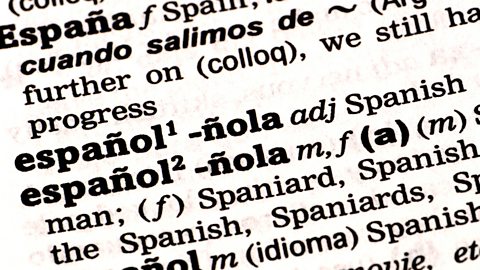
Learning to use a Spanish to English dictionary is an important skill we must work on. Developing this skill allows us to try to understand more challenging texts and use different language.
How to use a Spanish to English dictionary
There are some key points to remember when using a Spanish to English dictionary:
- The words go in alphabetical order just as they do in English
- You can look up a Spanish word to find out what it means in English
- You can look up an English word to find out how to say it in Spanish
- Some words may not be in the dictionary exactly as you find them (see next section for more information on this)
Looking up verbs
When looking up verbs in a Spanish to English dictionary, this can be a bit tricky. Sometimes verbs do not appear in the dictionary exactly as you find them in a text.
There are some reasons for this:
- You will not find individual parts of verbs in the dictionary, you will only find the infinitive.
For example:
- You will not find bebo, but you will find beber
- You will not find escribo, but you will find escribir
For this reason, it is important to recognise different parts of regular verbs. You should look up a similar word ending in AR, ER or IR to find the meaning. Some dictionaries will also say verb or use the symbol vb to tell you that you are looking up a verb.
- Irregular verbs are a bit harder to spot, so you will have to be able to recognise the verbs that they come from.
For example:
- You will not find tengo, but you will find tener
- You will not find hago, but you will find hacer
Some dictionaries (but not all) will tell you which infinitive to look up. If not, though, look up a similar word ending in AR, ER or IR.
Looking up negative expressions
If a word in Spanish has вҖҳnҙЗвҖҷ in front of it, this makes it negative.When looking up these words in the dictionary, we do not look up the вҖҳnҙЗвҖҷ but we must translate it.
For example
- no tengo - I donвҖҷt have
- no son - they are not
- no jugamos - we donвҖҷt play
вҖҳNҙЗвҖҷ does not always translate to the same word in English, but by understanding the rest of the sentence, you should be able to work this out. The important thing is to remember that it is there.
Phrases using more or less
When we are looking up a word, it is really important to check what other words are next to it. If the word вҖҳmГЎІхвҖҷ or вҖҳmұрІФҙЗІхвҖҷ is there, this can change the meaning.
For example:
- Juan es mГЎs alto que Pedro - Juan is taller than Pedro
- Mi madre es mГЎs paciente que mi padre - My mum is more patient than my dad
- Soy menos gruГұГіn que mi amigo - I am less grumpy than my friend
- Hay menos personas en Escocia que en Inglaterra - There are fewer people in Scotland than in England

Looking up adjectives
Adjectives are either masculine, feminine, singular or plural. When looking up adjectives in the dictionary, we should be looking for the masculine singular version.
For example:
- You will not find ІхҫұіҫұиГЎіЩҫұіҰҙЗІх, but you will find ІхҫұіҫұиГЎіЩҫұіҰҙЗ
- You will not find guapa, but you will find guapo
- You will not find ұиұрұзіЬұрГұІ№Іх, but you will find ұиұрұзіЬұрГұҙЗ

Words with more than one meaning
Some words in Spanish can have more than one meaning. To work out what they mean you can use the context, in other words, choose the most sensible option based on the other words in the sentence.
For example
- hacer - to do/to make
- іҫІ№ГұІ№ІФІ№ - tomorrow/morning
- tiempo - weather/time
- banco - bank/bench
Dictionary Symbols
Dictionaries use symbols to help us understand what type of word we are looking up.
Some of the common symbols to look out for are:
| Symbol | Meaning |
|---|---|
| nm | masculine noun |
| nf | feminine noun |
| nmf | masculine and feminine noun |
| adj | adjective |
| vb | verb |
| pron | pronoun |
| pp | preposition |
Quiz
Choose the correct translation for each Spanish word in this short quiz on using a Spanish dictionary.
More on Using Spanish language
Find out more by working through a topic
- count1 of 4

- count2 of 4

- count3 of 4
